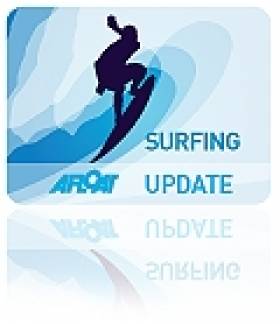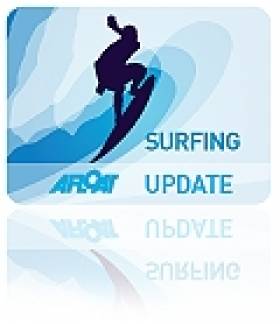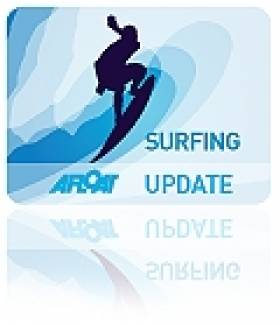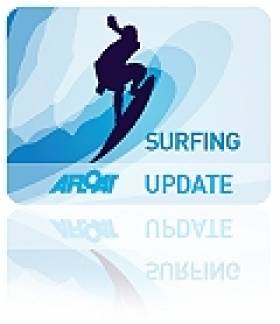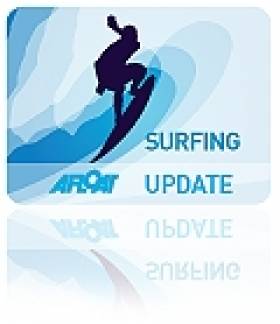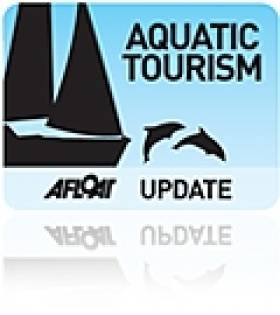Displaying items by tag: Surfing
Cornish Surfer Rides Ireland's Record Biggest Wave
#SURFING - British surfer Jayce Robinson wasn't about to let the largest wave ever recorded off Ireland's shores go by without giving it a shot.
And as Sky News Online reports, he was captured doing exactly that on Tuesday afternoon.
The Cornish surfing pro told the website: "It was definitely the biggest barrell I've ever surfed.
"I was a little nervous but I didn't have time to think about it - it's almost like a car crash, you don't know what's happening."
Robinson rode the giant wave for 20 seconds before the lip crashed down and knocked him off his board.
His surfing partner Lyndon Wake, who towed him to the swell at Mullaghmore Head, said: "It's always a worst case scenario when your tow partner wipes out. Lucky he managed to come out the other side OK."
As previously reported on Afloat.ie, storm force winds off the coast of Donegal produced monster rollers of over 20 metres (over 60 feet) in height detected in Donegal Bay.
Mullaghmore Head will once again welcome the world's top big wave surfers for the second annual Tow-In Surf Session in the New Year.
Van Gelderen Claims Irish Speed Sailing Title for 2011
#WINDSURFING - Oisín van Gelderen is all but confirmed as Irish Speed Sailing Champion for the second year running.
His national record speed (44.23 knots by 5x10 second average and 43.96 knots over 500m) puts him far ahead of his nearest competition in the rankings.
But his competitive spirit would not let him rest on his laurels.
"Ever since setting that record in February, I have been trying to beat it," he said, "and we had a really good day on Thursday in Dungarvan."
Though he did not beat his averages, he did set a new Irish record for peak speed at 47.89 knots (verification pending).
Van Gelderen dedicated his previous national title win to to the memory of Surfdock founder Alan Harris and Irish 500m speed record holder John Kenny, who both passed away in 2010.
Meanwhile, his Surfdock teammate Noelle Doran has taken the women's title for 2011 with a very impressive set of times for the year.
Her Irish women's peak record of 38.17 knots was complemented by third overall place for 2011 by 5x10 second average and first in the world over 500m.
"I'm so delighted for her," said Van Gelderen. "She had a nasty injury a few years ago, where she dislocated her hip while windsurfing. The resulting nerve damage put a stop to her competing in Waves and Freestyle, where she had multiple national titles."
Tramore Surf Clubs Plans New Clubhouse and Training Centre
#SURFING - Tramore Surf Lifesaving Club is seeking planning permission for the development of a new clubhouse and national training centre on Tramore's promenade.
The state-of-the-art development would involve the completion of a three-storey ocean-themed building along the seafront, with club changing facilities and a shower area; rescue boat housing; an emergency first aid room; conference room; and a lifeguard area with an observation deck on the third floor.
The building would also incorporate the latest in renewable energy technologies to minimise the club's carbon footprint and tailoring our energy usage to our needs.
It is projected that the new clubhouse would also house Waterford County Council's beach lifeguards during the summer months, which will also allow for co-operation in relation to water safety and lifesaving skills.
Waterford Today has more on the surf club's proposals HERE.
Teen Surfers Honoured for Saving Boy from Drowning
#WATER SAFETY - Two teenage surfers have been honoured for their brave effort in rescuing a young boy from drowning earlier this year, The Irish Times reports.
Bernard Cahill, 17, and Donough Cronin, 16, from Ennis received Just in Time Awards at Irish Water Safety's annual awards ceremony in Dublin Castle on Tuesday.
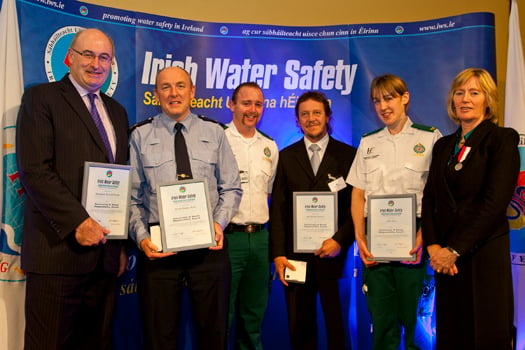
The duo were recognised for going to the aid of nine-year-old Gearóid Rogers, who was caught in a rip current near Spanish Point with his father Ger.
The Rogers family paid tribute to the surfing teens at the ceremony, with Ger saying he and his son were "lucky to be alive" thanks to their actions.
Children's Surfing App Makes a Splash Overseas
#SURFING - A Dubliner's iPhone app created to teach children about the ocean is making waves on both sides of the pond.
As Silicon Republic reports, the interactive app is the brainchild of surfing fan Shane Janssens, based on the Walter The Wandering Wave character he created to educate children about waves and their origins.
Devised after his move to Canada, Walter first appeared in a children's book developed by Janssens for his own business Belly of Fire Publishing before making the leap to the mobile realm.
"My idea was if waves could talk what amazing adventures they would share with us and what great friends they would meet along the way," he says.
Silicon Republic has more on the story HERE.
Easkey Britton Talks About Her 'Whirlwind' Year in Surfing
#SURFING - Irish surfing ace Easkey Britton sat down with Cooler magazine to chat about her "whirlwind" last few months.
Britton, who comes from the highly regarded Donegal surfing dynasty, has spent much of this year jugging her studies towards a PhD in marine science with her training for the European Surfing Championships in her home county this past September.
"I don’t know how anyone survives their PhD without being able to jump in the sea and catch some waves," she says. "It clears my mind, renews my energy – the best ‘study breaks’ you can get. And I appreciate the sessions I have a lot more."
Now heading into winter, with the surf getting bigger every day, she's in training with tow partner Neil Britton for the second Tow-In Surf Session at Mullaghmore Head.
She says of last year's inaugural competition: "The conditions were unreal. Huge, clean, light winds, sunshine. A very rare combo. It was our first ever experience of something like that. The crowds covering the headland were massive, it felt like an amphitheater, or being a gladiator in the arena!"
Britton also talks about how her family has been a big inspiration to her both in her life and her accomplishments on the surfboard.
Cooler has more on the story HERE.
Irish-American Surfs 'World's Biggest Wave'
#SURFING - An Irish-American has ridden what's being called the biggest wave ever surfed in the world.
Garrett McNamara from Hawaii caught the 90-foot monster wave off the coast of Nazaré in Portugal earlier this month, The Irish Times reports.
"Everything was perfect, the weather, the waves," said Northern Irish surfer Al Mennie, who was tow-in surfing with McNamara and English rider Andrew Cotton when the giant swell arose at Praia do Norte.
The offshore area is noted for its deepwater canyon that channels massive swells from the Atlantic.
“As I rode this wave, it seemed pretty massive, but I couldn’t tell quite how big it was,” McNamara told surf forecast site Surfline.
“When I got to the bottom and turned and got around the wave and went to kick out, it landed on me and it felt like a ton of bricks.
"Probably one of the most powerful waves ever to land on me at the shoulder," he added. "It was pretty amazing.”
McNamara - whose family has Irish roots, according to Irish Central - is working with the Portuguese Hydrographic Institute as part of the ZON North Canyon Project, which aims to learn how waves reach such significant heights at Praia do Norte.
See video of the record-shattering wave ride below:
The Wait Begins for Second Tow-In Surf Session
#SURFING - The waiting period for the second Tow-In Surf Session at Mullaghmore Head is now under way.
The invite-only list of the world's top big wave surfers has until 1 March 2012 to try to best the monster waves ridden in last February's inaugural contest.
Irish pioneers Richie Fitzgerald, Peter Conroy and Glyn Ovens will be on call for the return event, which has also invited back open teams winners Benjamin Sanchis and Éric Rebière, according to Surfworld Bundoran.
Sanchis is also the 2011 Billabong XXL biggest wave award winner, and intends to defend his crown in Sligo.
“Mullaghmore is a spectacular wave, but you really need to be prepared to surf big waves there," he said.
The first Tow-in Surf Session - which was even immortalised in a documentary - was organised by the Irish Surf Rescue Club in part to dispel the myth that tow-in surfing, where surfers are towed by jetski to bigger offshore waves, is an irresponsible activity.
“Our team has put an enormous amount of training, both here and abroad, to ensure that the sport of tow surfing and this event can be as safe as possible," said organiser Paul O'Kane.
The latest news on the second Tow-In Surf Session will be made available on the Billabong website HERE.
Fáilte Ireland Highlights 'Huge Potential' of Marine Tourism
#AQUATIC TOURISM - Water-based activities from kayaking to surfing to diving have a "huge potential" for Irish tourism.
That was the message from Fáilte Ireland's Outdoor Adventure and Activity Forum in Westport, Co Mayo this week, The Irish Times reports.
Figures announced at the forum showed that angling tourism accounted for €58 million in revenue, while surfing attracted 52,000 visitors - a low number considering Ireland's growing reputation in the sport.
Fáilte Ireland's Brian Maher said that the agency is working on a new strategy for aquatic tourism to take advantage of Ireland's potential in the area, aiming to develop activities from angling to cruising and sailing to surfing.
“One of Ireland’s great strengths has been in angling," he said. "There is still tremendous potential there for that core group of anglers.
"It is incumbent on us to develop this and other water-based activities properly because there is so much potential there.”
Bethany Hamilton: 'I Would Have Been Lost Without Surfing'
Last Saturday's Irish Times features an interview with Hawaiian surfing champion Bethany Hamilton who was in Bundoran for Eurosurf 2011 - where the film of her incredible true life experiences, Soul Surfer, had its gala premiere.
As previously reported on Afloat.ie, Soul Surfer tells the story of how Hamilton battled against all odds to become a champion again after losing her arm in a shark attack when she was just 13 years of age.
Most people would be put off surfing for life after such an ordeal, but Hamilton felt she would be lost without it.
"My passion for surfing outweighed my fear of sharks or anything else that might stop me from going in there," she said. "I was so excited to be back in the ocean and once I did it I felt like I was back at home and where I felt comfortable."
The Irish Times has more on the story HERE.


























